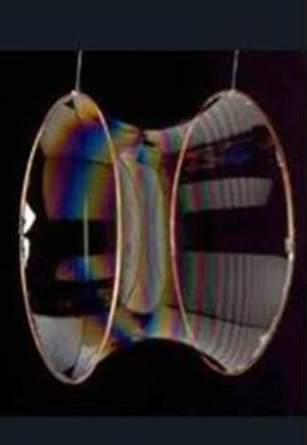2.2: A Soap Film Between Two Horizontal Rings- the Euler-Lagrange Equation
- Page ID
- 29955

This problem is very similar to the catenary: surface tension will pull the soap film to the minimum possible total area compatible with the fixed boundaries (and neglecting gravity, which is a small effect).
(Interestingly, this problem is also closely related to string theory: as a closed string propagates, its path traces out as “world sheet” and the string dynamics is determined by that sheet having minimal area.)

Taking the axis of rotational symmetry to be the x -axis, and the radius \(y(x)\), we need to find the function \(y(x)\) that minimizes the total area ( \(ds\) is measured along the curve of the surface). Think of the soap film as a sequence of rings or collars, of radius \(y\), and therefore area \(2 \pi y d s .\)The total area is given by integrating, adding all these incremental collars,
\[J[y(x)]=2 \pi \int_{x_{1}}^{x_{2}} y d s=2 \pi \int_{x_{1}}^{x_{2}} y \sqrt{1+y^{\prime 2}} d x]\
subject to given values of \(y\) at the two ends. (You might be thinking at this point: isn’t this identical to the catenary equation? The answer is yes, but the chain has an additional requirement: it has a fixed length. The soap film is not constrained in that way, it can stretch or contract to minimize the total area, so this is a different problem!)
That is, we want \(\delta J=0\) to first order, if we make a change \(y(x) \rightarrow y(x)+\delta y(x)\). Of course, this also means \(y^{\prime}(x) \rightarrow y^{\prime}(x)+\delta y^{\prime}(x) \text { where } \delta y^{\prime}=\delta(d y / d x)=(d / d x) \delta y\)


